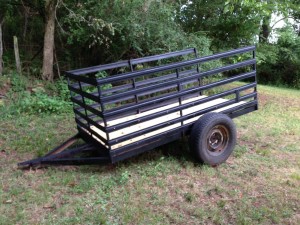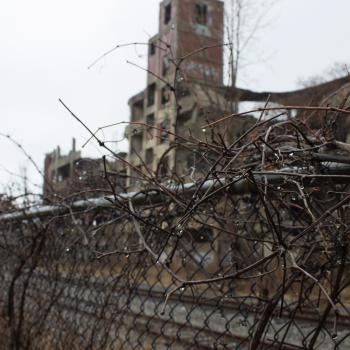 The year has turned, and I have yet another chapter in the annals of things I’ve learned from farming in the quasi-way that I do it—on breaks in my teaching schedule and long weekends away from work.
The year has turned, and I have yet another chapter in the annals of things I’ve learned from farming in the quasi-way that I do it—on breaks in my teaching schedule and long weekends away from work.
Last summer, I found an old wagon off the side of the road on the back of our place. It had been abandoned there around twenty or thirty years ago, forged together by a man who was once a metalworker, long gone now. It seems he used the axle from an old car, then built a metal box frame around it. He then installed a ply board floor, and fashioned some kind of a tongue that would allow the wagon to be secured to the back of a tractor with a linchpin.
“Found” the wagon is a way of putting it. I knew it was there all along. Every time I went down the dirt road to the back of the place, I could see a mound of honeysuckle over it, like a piano hidden in a Tim Burton movie. The wagon was full of old fence posts—fencing being one of the main preoccupations of any farm devoted mostly to livestock and horses.
Why it had been left there for so long I can’t say and nobody can remember. I assume it was because much of the place was later developed into a subdivision, and there was no need for it anymore. What fencing had to be done could be managed with a truck.
At any rate, having passed the mass of honeysuckle year after year, last summer something got into me. I decided to get the thing out. So during whatever time I could steal from other tasks, I labored at the undertaking. It was hot, mosquito-infested work, and I suspect more than one snake decided to slither off in another direction due to the noise, which prompted me to make a louder job of the work than was probably necessary.
First, it was a matter of clearing out the vines and trees that had grown up in and around the wagon. That meant a chainsaw and brush loppers. It’s amazing how vines and saplings can grow around and up and through things, holding onto the rails and wheels and axles in Gordian knots. Alexander didn’t have a sixteen-inch Homelite, but he passed through my mind from time to time even so.
Once all the brush was cleared, I began the work of emptying the bed. The posts were mostly rotten, so I threw them into the back of a truck I pulled alongside, then carried them to the dump. Eventually, I got down to the ply board floor, which had rotted through to the metal frame below. A couple of good bounces and I shattered it, so that the skeleton of metal was all that was left.
Predictably, the tires were sunken down into the earth and had gone flat. At least one of them was; miraculously, the other retained some air. So the next job was digging out around the rubber to free the tires so that I could bust the wagon loose. I also had to dig the tongue out of the earth, jack it up, and stick a pole beneath the bar so that I could get a logging chain around the brace posts. Then, in a triumph of four-wheel driving, I broke the wagon free of its decades-long confines and dragged it out to clear ground.
Next, I sanded down the metal, painted the structure with black Rustoleum, put in a new ply board floor, and bought a serviceable tire at a discount store (using about two gallons of Fix-A-Flat on the other one in a fit of thriftiness). All told, I put about fifty dollars into the job, but the reclamation was complete. A few pictures from a digital camera testified to the fact, and I began the task of trying to market the wagon. In a world gone mad with restoration fever, I was sure things would move quickly.
But everybody I contacted about it—farmers and landscapers –showed only a passing interest. None of the things I thought would make it more valuable than the newer models seemed to hold much weight. The frame was more solid than anything you could buy—a metal worker had made it, after all—and the sides were high enough to landscape with or even to carry a calf (my fanciful imagination at work).
The new paint, the new tires, the new floor—none of them seemed to matter. I didn’t even price it; I just asked for offers and would’ve taken anything reasonable.
Still, after months of trying, the only way I could sell the wagon was to throw it in with a newer wagon purchased a few years ago at a trailer store. In fact, according to the math, I really just gave it away.
It could be that I overestimated the value of the enterprise. I thought a great deal of myself for my efforts and the beauty of the thing I reclaimed from the wild. But the truth is, the wagon was very heavy, took a special kind of hitch, and isn’t all that practical (after all, who needs to take a single calf anywhere? There are no county fairs anymore and this isn’t Charlotte’s Web territory).
The bottom line is that I’m the kind of guy who wants to make money on what I’m proud of, not the kind who takes pleasure in a job well done. Things in themselves do not give me as much pleasure as those goods that are fungible.
That flaw will need to change at some point; it will be my self-improvement project this year. However, according to my conscience, the catalog of such yearly promises is growing rather daunting. At this rate, I’ll have to live a long time to get it done.
A.G. Harmon teaches Shakespeare, Law and Literature, Jurisprudence, and Writing at The Catholic University of America in Washington, D.C. His novel, A House All Stilled, won the 2001 Peter Taylor Prize for the Novel.
Photo by A.G. Harmon.











